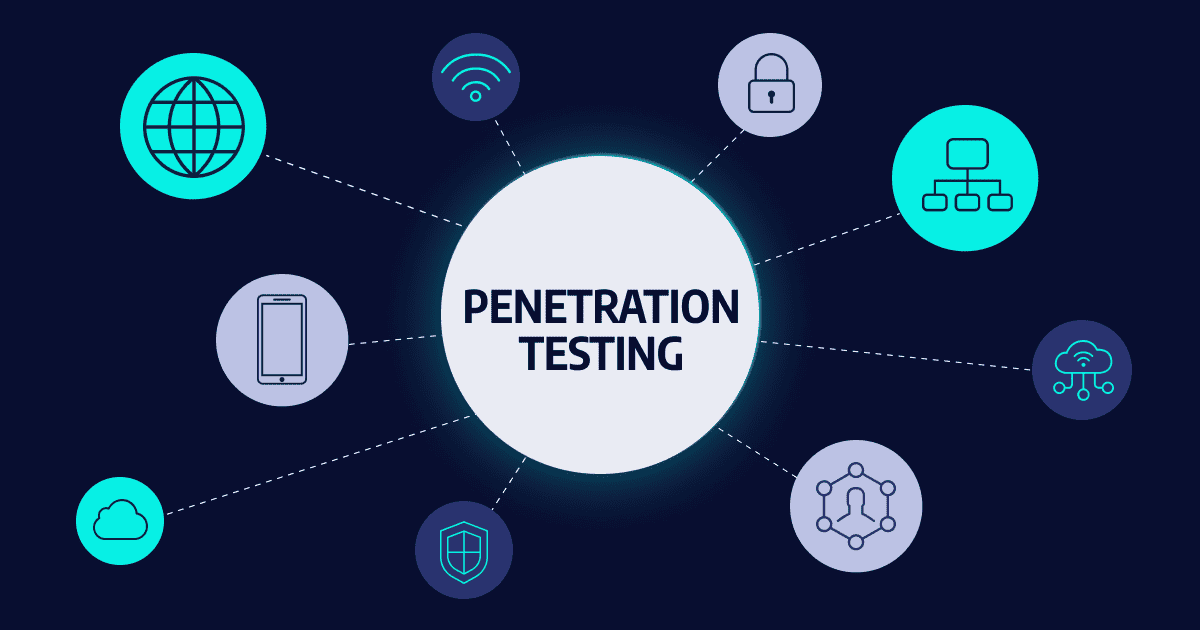What is Penetration Testing? Why It’s Vital, Its Types, Benefits and How PCApps Can Help
In the era of digitization, every business is susceptible to the threat of cyber-attacks. While technology has unlocked a universe of opportunities, it has also left us vulnerable to an array of potential security breaches. This is where penetration testing, or pen testing, as it’s commonly referred to, comes into play. It’s a strategic move to ensure your business’s cyber defense mechanisms are up to date. And, while PCApps may not directly perform penetration testing, our extensive experience managing and overseeing this process makes us a trusted ally in securing your business.
Understanding Penetration Testing
What is Penetration Testing?
Penetration testing, often referred to as pen testing, is a methodical and controlled approach to assessing the security posture of a system, network, or application. It involves simulating real-world cyberattacks to uncover vulnerabilities that could be exploited by malicious actors. By mimicking the actions of hackers, penetration testers help organizations identify weaknesses before they can be exploited by cybercriminals.
There are different types of penetration tests, each providing a unique perspective on your system’s security. These include:
- Black Box Testing: In this, the tester knows nothing about the system being attacked. The goal is to simulate an external hacking or cyber attack.
- White Box Testing: Conversely, in white box testing, the tester has complete knowledge of the system being tested. It’s more detailed and exhaustive as the tester knows the system’s ins and outs.
- Grey Box Testing: This is a combination of both black and white box testing. The tester has some knowledge of the system, making it a more realistic simulation of internal security breaches.
The Importance of Penetration Testing
Penetration testing plays a critical role in an organization’s overall security strategy. It goes beyond automated vulnerability scanning by simulating real-world attack scenarios. This proactive approach allows companies to identify vulnerabilities and weaknesses in their systems, networks, and applications before cybercriminals have a chance to exploit them. By uncovering these vulnerabilities, organizations can take appropriate steps to remediate them, thereby enhancing their overall security posture.
Penetration Testing vs. Vulnerability Scanning
While vulnerability scanning is an important component of an organization’s security strategy, it is crucial to understand the distinction between vulnerability scanning and penetration testing. Vulnerability scanning involves automated tools that scan systems and networks to identify known vulnerabilities. On the other hand, penetration testing takes a more comprehensive and active approach by manually probing systems to identify both known and unknown vulnerabilities. Penetration testing provides a more accurate assessment of an organization’s security and helps uncover vulnerabilities that automated scanning tools may miss.
The Benefits of Penetration Testing
Identifying Vulnerabilities
One of the primary benefits of penetration testing is the ability to identify vulnerabilities that could be exploited by attackers. By simulating real-world attack scenarios, penetration testers can uncover weaknesses in systems, networks, and applications that may have otherwise gone unnoticed. This allows organizations to prioritize and address these vulnerabilities, reducing the risk of successful cyberattacks.
Proactive Defense Strategy
Penetration testing provides organizations with a proactive defense strategy. Instead of waiting for an attack to occur, organizations can proactively assess their security posture and identify potential vulnerabilities. This enables them to implement necessary security measures to prevent attacks and protect sensitive data.
Compliance and Regulatory Requirements
Many industries have compliance and regulatory requirements that mandate regular security assessments, including penetration testing. By conducting penetration tests, organizations can ensure they meet these requirements and avoid potential penalties or legal repercussions. Additionally, penetration testing helps organizations demonstrate due diligence in safeguarding sensitive data.
Customer Trust
In today’s digital landscape, customers expect organizations to prioritize the security of their data. By conducting penetration tests and implementing appropriate security measures, organizations can instill confidence in their customers that their information is being protected. Demonstrating a commitment to security enhances customer trust and can provide a competitive advantage.
Reduction in Potential Losses
Data breaches and cyberattacks can result in significant financial losses for organizations. Penetration testing helps identify vulnerabilities that could lead to breaches, allowing organizations to take proactive steps to mitigate the risks. By addressing vulnerabilities before they are exploited, organizations can significantly reduce the potential financial impact of a successful attack.
Enhanced Incident Response Capability
In the event of a security incident, having a well-tested incident response plan is crucial. Penetration testing allows organizations to assess the effectiveness of their incident response processes and identify areas for improvement. By simulating realistic attack scenarios, organizations can ensure that their incident response teams are well-prepared to handle potential threats.
The Penetration Testing Process
Planning and Scoping Before conducting a penetration test, it is essential to define the scope and objectives of the test. This involves identifying the systems, networks, or applications to be tested and establishing the goals of the testing exercise. Clear communication between the organization and the penetration testing team is crucial to ensure that expectations are aligned.
Reconnaissance
The reconnaissance phase involves gathering information about the target systems, networks, or applications. This can include researching publicly available information, such as company websites or social media profiles, to gain insights that could be useful during the test. Reconnaissance helps the penetration testers understand the target environment better and plan their attack vectors.
Vulnerability Assessment
During the vulnerability assessment phase, the penetration testers use a combination of manual and automated techniques to identify vulnerabilities in the target systems. This involves scanning for known vulnerabilities, misconfigurations, and weak security controls. The goal is to identify potential entry points that could be exploited by attackers.
Exploitation
In the exploitation phase, the penetration testers attempt to exploit the identified vulnerabilities to gain unauthorized access or escalate their privileges. This simulates a real-world attack scenario and helps organizations understand the potential impact of a successful breach. However, it is important to note that penetration testers operate within agreed-upon boundaries and do not cause any harm or damage to the target systems.
Post-Exploitation
After successfully gaining access to the target systems, the penetration testers perform additional tests to assess the extent of the compromise. This includes pivoting through the network, escalating privileges, and attempting to access sensitive data or critical systems. By simulating the actions of a skilled attacker, penetration testers help organizations understand the potential impact of a breach and the pathways an attacker could exploit.
Reporting and Remediation
Once the penetration testing is complete, the findings are documented in a comprehensive report. The report includes details of the vulnerabilities identified, the methods used for exploitation, and recommendations for remediation. This report serves as a valuable resource for organizations to prioritize and address the identified vulnerabilities, strengthening their security posture.
What Can Penetration Testing Be Used On?
Network Penetration Testing
Network penetration testing focuses on identifying vulnerabilities within a network infrastructure. It aims to uncover weaknesses in network devices, firewalls, routers, switches, and other network components. By simulating attacks from both external and internal perspectives, organizations can identify potential entry points and strengthen their network security.
Web Application Penetration
Testing Web application penetration testing involves assessing the security of web applications, such as websites, portals, and online services. It aims to identify vulnerabilities that could be exploited through web interfaces, such as SQL injections, cross-site scripting (XSS), and authentication bypass. By testing the security of web applications, organizations can protect customer data and prevent unauthorized access.
Mobile Application Penetration
Testing With the increasing popularity of mobile applications, it has become crucial to assess their security. Mobile application penetration testing involves evaluating the security of mobile apps on various platforms, including iOS and Android. This helps identify vulnerabilities that could lead to data leakage, unauthorized access, or compromised user privacy.
Wireless Network Penetration
Testing Wireless network penetration testing focuses on assessing the security of wireless networks, such as Wi-Fi networks. It involves identifying vulnerabilities in the wireless infrastructure, encryption protocols, and access control mechanisms. By conducting wireless network penetration testing, organizations can ensure the confidentiality and integrity of their wireless communications.
Social Engineering Penetration Testing
Social engineering penetration testing involves assessing the susceptibility of employees to social engineering attacks. It aims to uncover weaknesses in human interactions, such as phishing, pretexting, or baiting. By testing the organization’s resilience to social engineering tactics, organizations can educate their employees and enhance their overall security awareness.
Physical Penetration Testing
Physical penetration testing evaluates the physical security measures in place, such as access controls, surveillance systems, and alarm systems. It involves simulating physical breaches, such as unauthorized entry, theft of sensitive information, or tampering with physical infrastructure. By identifying physical security weaknesses, organizations can enhance their physical security measures.
PCApps: Your Strategic Partner in Penetration Testing
At PCApps, our role in the penetration testing process is invaluable. Even though we do not conduct penetration tests, we help manage, oversee, and interpret them. Here’s what we bring to the table:
Penetration Testing Management
We serve as the linchpin between your business and the penetration testers, managing the process from start to finish. We ensure that the process is conducted thoroughly and professionally, with minimal disruption to your operations.
Post-Testing Support
Our involvement doesn’t stop when the penetration test ends. We help you understand the findings, their implications, and guide you through the necessary steps to improve your systems.
Regular Security Audits
In addition to managing penetration testing, PCApps conducts regular security audits, offering an extra layer of protection to your digital infrastructure.
Penetration Testing in Summary
In the digital age, the value of robust cybersecurity measures, such as penetration testing, is incalculable. With its diverse forms and numerous benefits, penetration testing is an essential tool for businesses to protect their digital assets.
While PCApps does not conduct penetration tests, our role in orchestrating and supervising these exercises is vital. We’re here to guide, strategize, and support, helping to ensure your defenses are as robust as they can be. With PCApps, you can navigate the complexities of cybersecurity with confidence and peace of mind. Because at PCApps, we believe in making your business not just digitally advanced, but also digitally secure.
Interested in learning more about penetration testing or how the team at PCApps can help? Reach out to our team for a free consultation, we’re eager to partner with you!









